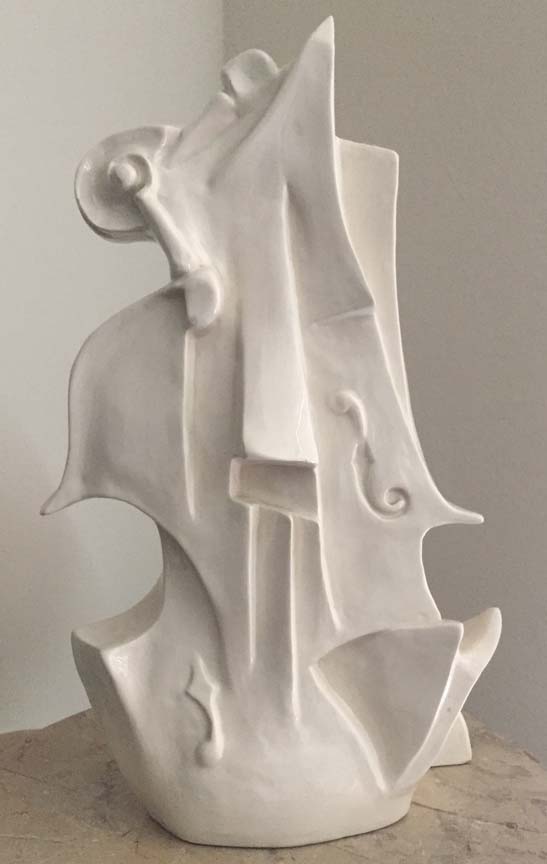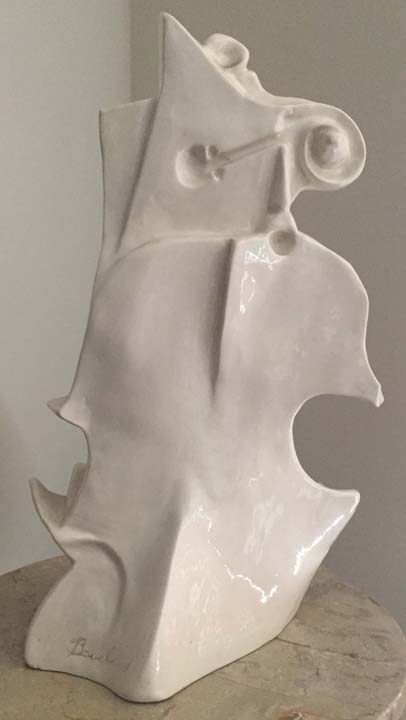

HENRI LOUIS BOUCHARD
"CUBIST VIOLIN"
UNIQUE CERAMIC, SIGNED
FRANCE, C.1925
15 INCHES

Jean Louis Bouchard 1875-1960 Born 13 December 1875, in Dijon; died 30 November 1960, in Paris. Sculptor, medallist, decorative artist. Mythological subjects, historical portraits, figures, animals. Monuments, low reliefs, groups, statues, medals. Art Deco. Henri Louis Bouchard was the son of a carpenter and a seamstress. He studied at the École des Beaux-Arts in Dijon before entering the studio of Barrias at the École des Beaux-Arts in Paris, where he was awarded the Grand Prix de Rome for sculpture in 1901. He stayed at the Medici Villa from 1902 to 1906. In Paris he taught at the Académie Julian (1910-1928), the École Nationale des Arts Décoratifs (1928-1929, and the École Nationale des Beaux-Arts (1929-1945). He became a Commander of the Légion d'Honneur, and was admitted as a member of the Institut in 1933. When he died, his family preserved his studio and partially opened it to the public in 1962. In 1984 the family donated some of his works to the Association des Amis d'Henri Bouchard, which made up the fund of the Atelier-Musée Henri Bouchard (Henri Bouchard Studio Museum) in Paris. When he was very young, Bouchard had admired and been deeply influenced by the tomb of Philip the Bold and the Well of Moses at the Chartreuse de Champmol, near Dijon. Both are the work of a Dutch sculptor, Claus Sluter, who had made his home in Burgundy. Sluter could be described as Bouchard's first teacher, and Bouchard later sculpted a statue of his imagined likeness, which now stands in one of the courtyards at the ducal palace in Dijon. When Bouchard was living at the Medici Villa the works he sent to Paris were not to the taste of the Institut members: they did not consider them to be traditional enough. Rather than conventional mythological or allegorical subjects, Bouchard preferred to sculpt working-class people, engaged in their manual activities. He was interested in working people throughout his career, and most of all prior to 1914. Examples include: Burgundy Grape-Picker; Roman Peasant of the Sabine Tribe; Cart; Docker at the Port of Naples; Miner at Work; and Blacksmith at Rest. These figures are probably his most original works. He had even hoped to erect a monument to the glory of work, although he never had the chance to achieve this ambition. Besides Claus Sluter, he sculpted many other figures, including Nicolas Rolin and His Wife Guigone de Salins; the founders of the Hospices de Beaune, who had commissioned the Retable of the Last Judgement from Van der Weyden; Pierre de Montereau; and Jean de Chelles. Bouchard sculpted not only figures from the past but also contemporary heroes, including the painter Henri Martin (1910), and the Dijon artist François Rude, whose work he greatly admired. In 1923 André Citroën commissioned a medal to commemorate the first Touggourt to Timbuktu car rally. Critics have noted that because he produced so many different types of sculpture he was therefore able to tackle a wide variety of themes: from historical figures, to charming young girls (such as Young Girl with a Fawn or Young Girl with a Gazelle), to animals (such as Two Tamed Horses and Rearing Horse). Bouchard also executed monumental sculptures: as early as 1909 he was commissioned to build the huge Monument to the Reformation in Geneva, on which he and Paul Landowski worked together in equal part. In 1910 he won a competition to build the Marey Monument () (in honour of a physiologist from Beaune). After World War I he sculpted several monuments to the dead, as well as some low reliefs for the façades of churches: the most memorable of these was for the church of St-Pierre de Chaillot in Paris, the interior of which Bouchard also decorated (1933-1934). In 1937 he erected the monumental Art Deco inspired Apollo group at the Palais de Chaillot in Paris. Bouchard's sculptures are eclectic in terms not only of form, but also in style, which he seems to have adapted to the subject in hand. He ranges from an almost Expressionist Realism when sculpting men at work, like the Docker, to a decorative idealised style for the Palais de Chaillot Apollo. His style ranges from robust and simple (with broadly carved planes) to slender (in his representations of young women) to Romantic, to classical (sober and sometimes even archaic). Nevertheless, looking at his entire output, a general stylistic evolution is discernible: at the beginning of his career he worked in a Realist style, still faithful to a 19th-century aesthetic, until around 1907 - the year he sculpted Pierre de Montereau. Later he felt the need to simplify his planes and thereby achieved a monumentality that he would never lose. In 1913 he moved towards a decorative style, utterly in the spirit of Art Deco, which is particularly noticeable in his medals. Finally, in 1930 he combined this decorative style with a monumental quality to produce something of a classical style (this was the time of his grand decorative works at the Palais de Chaillot and the church of St-Pierre de Chaillot). However, the evolution of his style was by no means rigid, and Bouchard always knew how to adapt his style to the subject in hand. Bouchard regularly exhibited at the Salon d'Automne and the Salon of the Société des Artistes Français, who awarded him a medal of honour in 1925, and gave him a seat on the jury at the Exposition Universelle of 1937. The Atelier-Musée Henri Bouchard organises regular thematic exhibitions of his work, which have included Man at Work (L'Homme au Travail) in 1969; Bouchard and the Citroen Trans-Saharan Rally (Bouchard et le Raid Citroën Transsaharien) in 1988; Animals (Les Animaux) in 1994; and Women Sculpted by Bouchard (Femmes Sculptées par Bouchard) in 2003. In 1975 the Musée des Beaux-Arts in Dijon held an exhibition to commemorate the centenary of his birth. In 2002 the town of Beaune organised a three-part exhibition of his work at the Musée du Vin de Bourgogne, the Musée des Beaux-Arts and the Musée Marey. Museum and Gallery Holdings Algiers (Mus. National des Beaux-Arts): Nicolas Rolin; Claus Sluter Antwerp (Koninklijk Mus. voor Schone Kunsten): Charles the Bold Antwerp (Openluchtmus. Middelheim): Head of a Child Beauvais (Mus. départemental de l'Oise): Basket-Bearers Boulogne-Billancourt (Municipal Mus.): Black Runner; François Rude; Henri Martin Bourg-en-Bresse (Mus. de Brou): Horse Race Cairo (Gezira Center for Modern Art): Young Girl with a Gazelle Chicago (AI): Resignation Dijon (MBA): 50 sculptures Geneva (MAH): Olivetan Lyons (MBA): Amabilis Mont-de-Marsan (Mus. Despiau-Wlérick): Head of a Black Man; Mother's Game; Sculptor; Architect New York (Metropolitan Mus. of Art): Blacksmith at Rest; Young Girl with a Gazelle; Young Roman Dancer Nîmes (MBA): The Sculptor and the Architect Paris (MNAM-CCI): Joseph Caillaux; Charles Duvent Paris (Mus. Bouchard): the whole studio fund Paris (Mus. Clémenceau): Clémenceau Paris (Mus. d'Orsay): Docker Paris (Mus. de la Marine): Sword of the Academician Fouqueray; Vauban Paris (Mus. des Arts décoratifs): Little African Donkey; Gazelle; Greyhound Rio de Janeiro (Mus. Nacional de Belas Artes): Bust of a Young Woman Smiling Semur-en-Auxois (Mus. municipal): Woman of Campania Senlis (Mus. de la Vénerie): Dog with a Wild Boar St-Quentin (Mus. Antoine-Lécuyer): Head of Claus Sluter; Motherhood
|